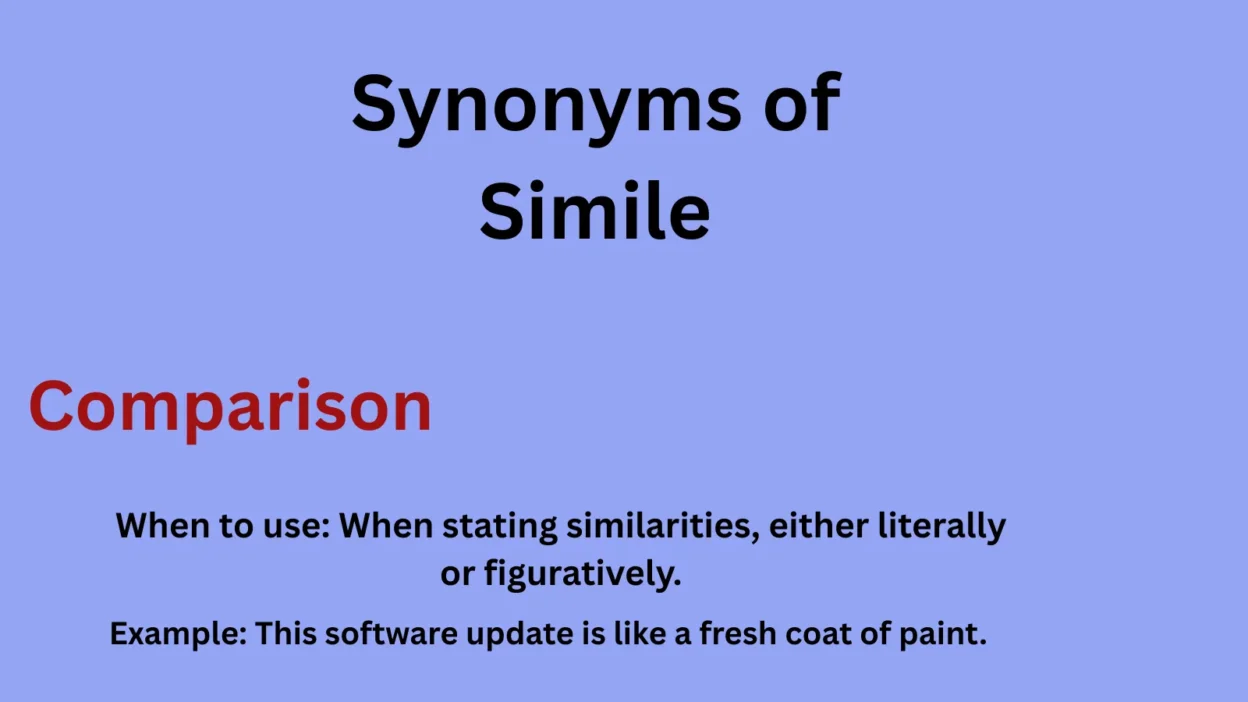Synonyms of simile—like comparison, figurative expression, analogy, and metaphorical phrase—offer different ways to describe how two unlike things are related through imagery. For example, in the simile “as busy as a bee,” the subject’s activity level is compared to the constant motion of a bee, making the idea more vivid.
These terms all highlight the function of enhancing understanding through illustration and creativity. Knowing when to use each synonym helps you sharpen your descriptive writing and bring clarity or emotion to your message.
If you’re analyzing literature or crafting vivid language, these alternatives to simile add depth and variety.
What Is a Simile?
At its core, a simile is:
- Figurative: It doesn’t mean what it says literally.
- Comparative: It draws a connection between two different things.
- Explicit: It uses “like” or “as” to make that comparison clear.
Similes often feel gentle, poetic, and imaginative. They’re typically modest and unassuming compared to stronger devices like metaphors. This reserved tone makes them accessible and widely used in everyday language, literature, and even song lyrics.
30 Synonyms and Alternatives to Simile
Each of these words shares some part of the simile’s DNA—be it comparison, imagery, or rhetorical function. Let’s break them down:
1. Metaphor
When to use: When you want a stronger, more direct comparison without using “like” or “as.”
Example: Her heart was a locked room.
Tone: Bolder, more immersive than a simile.
2. Analogy
When to use: To explain or clarify an idea through comparison.
Example: Running a startup is like raising a child.
Tone: Logical and illustrative.
3. Comparison
When to use: When stating similarities, either literally or figuratively.
Example: This software update is like a fresh coat of paint.
Tone: Neutral, versatile.
4. Likeness
When to use: When emphasizing resemblance.
Example: There’s a clear likeness between her style and 80s fashion.
Tone: Observational, often visual.
5. Parallel
When to use: To show similar structures or patterns, especially in arguments.
Example: There’s a parallel between social media and addiction.
Tone: Analytical.
6. Allegory
When to use: In extended comparisons or stories with symbolic meaning.
Example: Orwell’s “Animal Farm” is an allegory for totalitarianism.
Tone: Literary, layered.
7. Parable
When to use: To teach a lesson through metaphorical storytelling.
Example: The parable of the Good Samaritan teaches compassion.
Tone: Moral, often religious or spiritual.
8. Allusion
When to use: When referencing another work or concept indirectly.
Example: He had the patience of Job.
Tone: Cultural, subtle.
9. Symbol
When to use: When one object represents another abstract idea.
Example: The dove is a symbol of peace.
Tone: Poetic, interpretive.
10. Imagery
When to use: To evoke sensory experience through descriptive language.
Example: The crisp scent of pine filled the morning air.
Tone: Sensory-rich, creative.
11. Figure of Speech
When to use: Broadly, when referring to non-literal language.
Example: “Break a leg” is a figure of speech for good luck.
Tone: General, technical.
12. Trope
When to use: To describe recurring rhetorical devices or themes.
Example: The “reluctant hero” is a common trope in fiction.
Tone: Academic, critical.
13. Allegorical Expression
When to use: For expressions with hidden, often moral meanings.
Example: The storm was more than weather—it was life’s chaos embodied.
Tone: Deep, symbolic.
14. Euphemism
When to use: To soften a harsh or direct expression.
Example: “He passed away” is a euphemism for death.
Tone: Polite, indirect.
15. Hyperbole
When to use: To exaggerate for emphasis or humor.
Example: I’ve told you a million times!
Tone: Dramatic, often humorous.
16. Personification
When to use: To give human traits to non-human things.
Example: The wind whispered through the trees.
Tone: Poetic, emotional.
17. Idiom
When to use: For culturally understood phrases with non-literal meaning.
Example: It’s raining cats and dogs.
Tone: Casual, often informal.
18. Double Entendre
When to use: For phrases with two meanings, often risqué or witty.
Example: Marriage is a fine institution—but who wants to live in an institution?
Tone: Clever, playful.
19. Metonymy
When to use: When substituting a related term.
Example: The crown will decide. (Crown = monarchy)
Tone: Intellectual, stylistic.
20. Synecdoche
When to use: When part represents the whole or vice versa.
Example: All hands on deck.
Tone: Figurative, economical.
21. Irony
When to use: To express the opposite of what is stated, often for humor or criticism.
Example: The fire station burned down.
Tone: Witty, sarcastic, or tragic.
22. Analogue
When to use: To suggest a concept or character is similar to another.
Example: He’s the American analogue of Sherlock Holmes.
Tone: Scholarly, comparative.
23. Comparison Phrase
When to use: In casual or literal comparative writing.
Example: Much like her sister, she’s fiercely independent.
Tone: Conversational, clear.
24. Juxtaposition
When to use: To highlight contrast by placing things side by side.
Example: The light of hope against the shadow of despair.
Tone: Dramatic, artistic.
25. Cliché
When to use: When using overused metaphoric language.
Example: A diamond in the rough.
Tone: Familiar, sometimes tired.
26. Proverb
When to use: To express traditional wisdom.
Example: A stitch in time saves nine.
Tone: Timeless, cultural.
27. Maxim
When to use: For pithy, truth-based statements.
Example: Honesty is the best policy.
Tone: Moral, instructional.
28. Aphorism
When to use: To share concise insights or truths.
Example: Life is short, art is long.
Tone: Reflective, philosophical.
29. Epigram
When to use: For clever, concise, and often witty sayings.
Example: I can resist everything except temptation.
Tone: Witty, sharp.
30. Descriptive Comparison
When to use: For straightforward, image-rich comparison.
Example: The mountain looked like a sleeping giant.
Tone: Neutral, imagery-focused.
How to Choose the Right Alternative
Choosing the right synonym depends on your intent, tone, and audience:
- Want to explain a complex idea? Try an analogy or a metaphor.
- Writing something poetic? Use personification, imagery, or symbol.
- Crafting a speech or essay? Go with a figure of speech, allegory, or parallel.
- Aiming for clarity in everyday writing? Stick with comparison, likeness, or a comparison phrase.
- Want to add humor or bite? Use irony, epigram, or double entendre.
Also, consider cultural and emotional context. For example:
- Idioms may not translate well across cultures.
- Proverbs often carry cultural values.
- Clichés may come off as unoriginal unless used intentionally.
Conclusion
In summary, exploring the synonyms of simile reveals the richness and variety available when describing comparisons in language. Words like analogy, figurative expression, and comparison each bring subtle differences in tone and use, allowing you to tailor your language to the context, whether academic, creative, or conversational.
These alternatives don’t just replace the word simile; they open up new ways to express similarity, deepen understanding, and enhance imagery.
As you refine your writing or analysis, let these synonyms guide you in crafting language that’s not only clear but also colorful and engaging.

